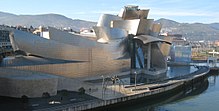.svg/400px-Biscay_in_Spain_(plus_Canarias).svg.png)
Biscay (in Basque and officially Bizkaia) is a province of Spain and a historical territory of the autonomous community of Basque Country, heir to the old manor of Vizcaya. Its capital is Bilbao. In it there was a massive industrialization of the late nineteenth century and the first half of the twentieth century. At present, industrial activity has given way to activity in the services sector, especially after the profound deindustrialization suffered during the 1970s and later.

Vizcaya place name
Vizcaya is the name in Spanish, recommended by the Royal Academy of the Spanish Language. It is used in unofficial documents and, in general, in the Spanish-speaking written sphere. It is also the name that was used in the Castilian version of the Spanish Constitution of 1978 and in the Castilian version of the Statute of Autonomy of the Basque Country of 1979.
Gastronomy
Seafood and meat

The marmitako is a dish of bonito with potatoes in the style of Lequeitio and Ondárroa. Among the cod and fish dishes there are numerous cases with the denomination a la vizcaína and a la bilbaína. There are cod in Biscay, hake in Bilbao, sea bream in Bilbao, scorpion in Bilbao. Santurce sardines, popularized in a song, are usually served roasted in August. A traditional dish is the Bilbao eels. Among the seafood are squid in its ink, the Biscayan lobster, the crab that is served on the skeleton of a spider crab.
Among the small game meats are quail with muscat grapes. Among the pork meats, the pork tenderloin with Idiazábal cheese sauce, the red beans with blood sausage, the white beans with chorizo peppers stand out.
Vegetables
Vegetables and vegetables are synthesized in a vegetable stew called Bilbao. Legumes are often used in stews and stews that are very popular in the province. In the same way the piparrada. The fresh beans to Bilbao. There are preparations of stuffed peppers called Bilbao. Among the mushrooms, the Guiberludiños are very popular.
tourism



Its capital, Bilbao, is famous for the Guggenheim Bilbao museum and its estuary.
Monuments and places of interest:
- Meeting House and Tree Guernica
- Las Encartaciones and the Casa de Juntas de Avellaneda
- Pozalagua Caves
- Vizcaya Bridge
- Santimamiñe Cave and Oma Forest
- Euskalduna Palace
- San Juan de Gaztelugache and Isla de Aqueche, in Bermeo.
- Port of Bermeo and Puerta de San Juan
- Church of Santa María de Axpe
- Urdaibai Biosphere Reserve and Mundaca Beach
- Basilica of the Assumption of Our Lady of Lequeitio, its Altarpiece and the Virgen de la Antigua
- Basilica of Begoña
- University of the Basque Country, Lejona campus (1972), extensive example of brutalist architecture, and headquarters of the Basque Museum of the History of Medicine and Sciences
- Museum of old and classic cars of Torre Loizaga, with more than 40 Rolls Royces
- Bilbao airport, an example of modern architecture
- Hermitage of San Pedro (Abrisketa) in Arrigorriaga
- Ornithological museum Urdaibai Bird Center, in Gautéguiz de Arteaga
Most populated municipalities
| Most populated municipalities (2011)[1] | |||||||
|---|---|---|---|---|---|---|---|
| Position | Municipality | Population | |||||
| 1st | Bilbao | 352.700 | |||||
| 2nd | Baracaldo | 100.061 | |||||
| 3rd | Gecho | 80.089 | |||||
| 4th | Portugalete | 47.742 | |||||
| 5th | Santurce | 47.076 | |||||
| 6th | Basauri | 42.166 | |||||
| 7th | Faraway | 30.454 | |||||
| 8th | Galdacano | 29.049 | |||||
| 9th | Sestao | 28.959 | |||||
| 10th | Durango | 28.226 | |||||
| 11th | Erandio | 24.262 | |||||
| 12th | Amorebieta | 18.140 | |||||
| 13.ª | Bermeo | 17.078 | |||||
| 14.ª | Munguía | 16.737 | |||||
| 15th | Guernica | 16.442 | |||||
References
- ↑Source: INE (National Institute of Statistics of Spain) (01-01-2011). Official population figures resulting from the revision of the Municipal Register as of January 1, 2011
external links
 Wikimedia Commons houses multimedia content about Biscay. Commons
Wikimedia Commons houses multimedia content about Biscay. Commons Wikipedia has an article on Biscay.w: Vizcaya
Wikipedia has an article on Biscay.w: Vizcaya- Official website of the Provincial Council of Vizcaya
